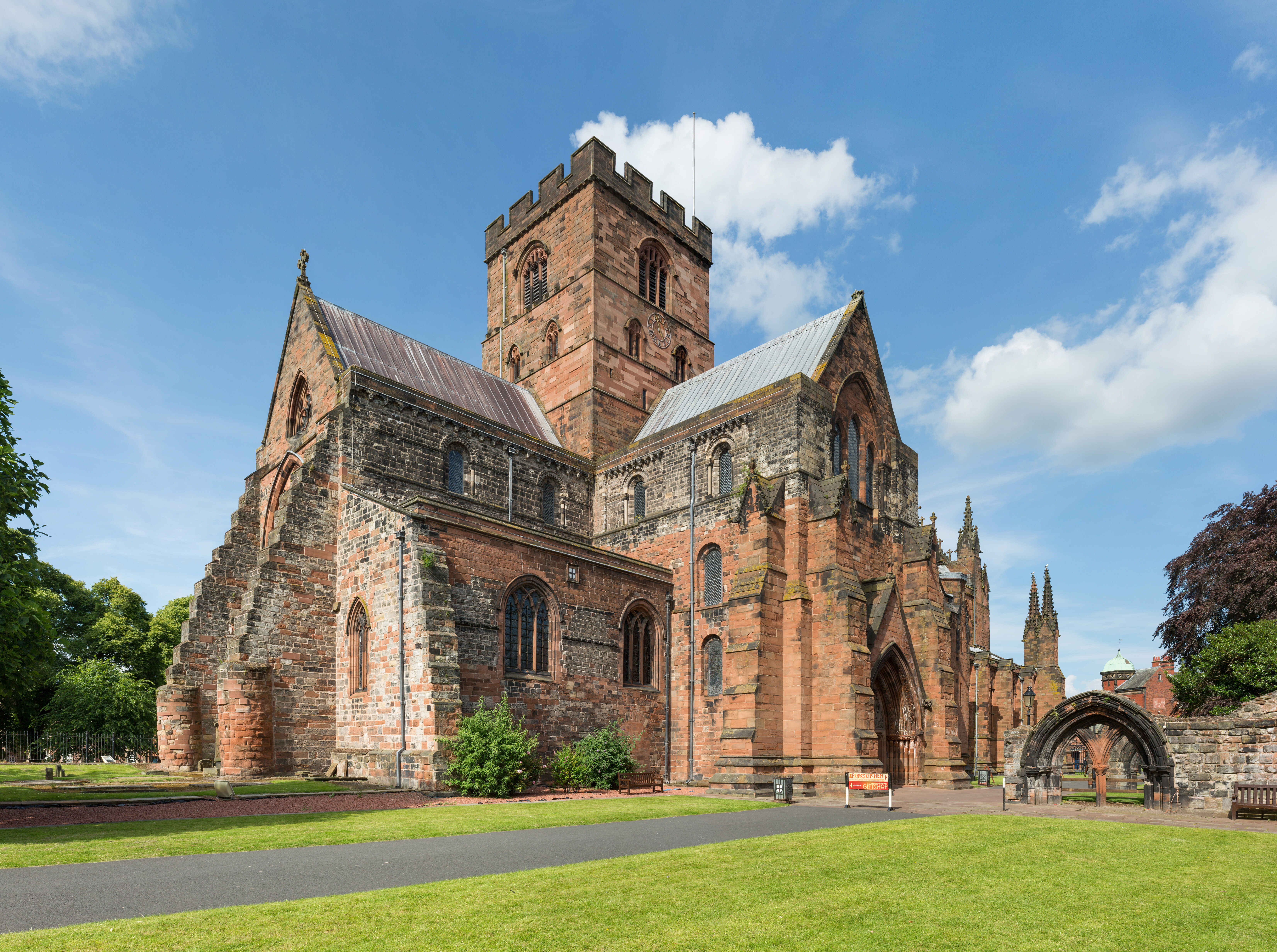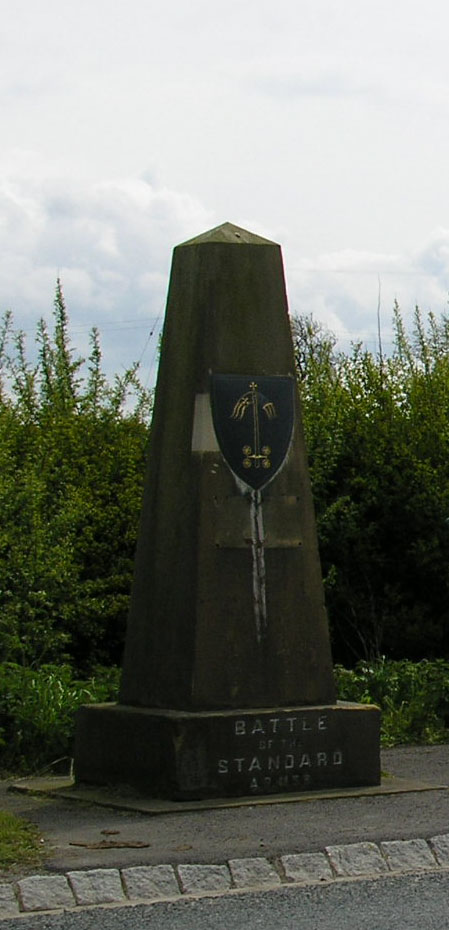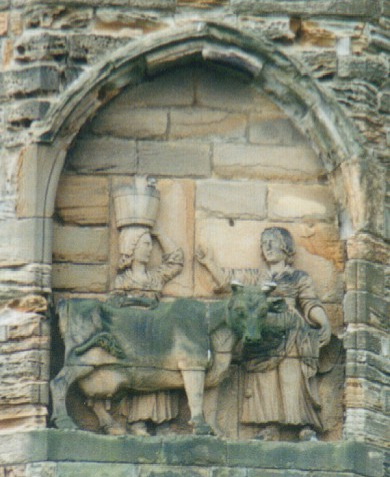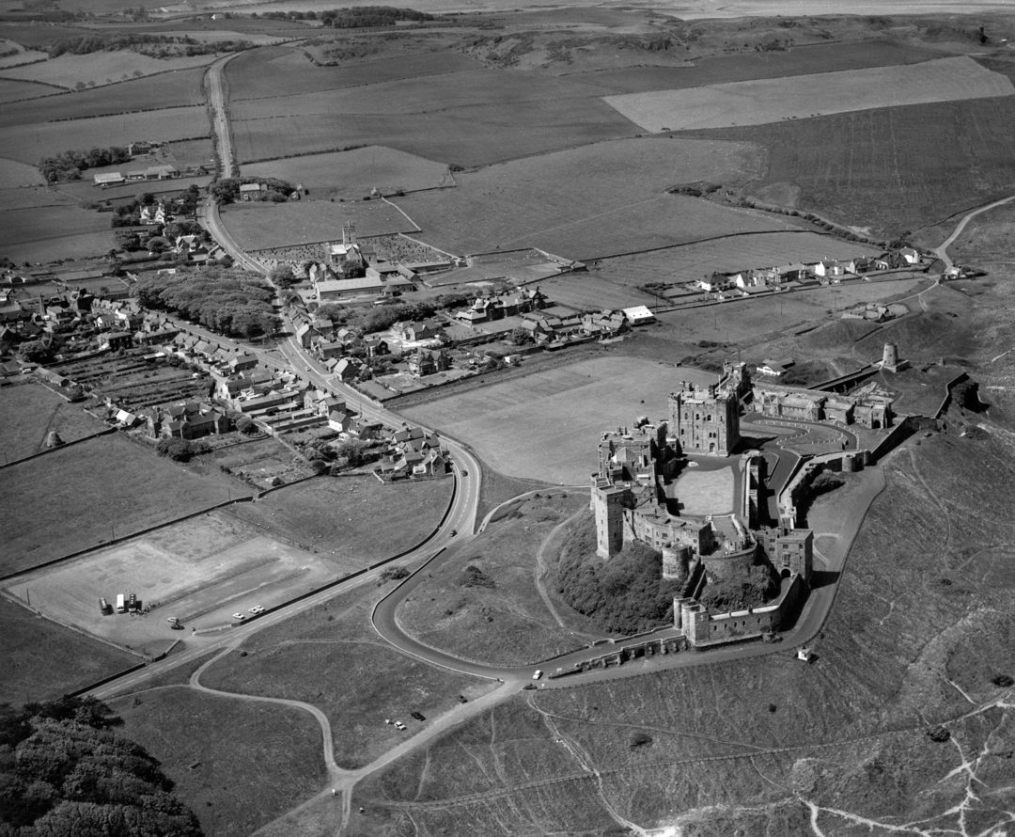|
Siege Of Wark (1138)
The siege of Wark is a 1138 siege of Wark on Tweed Castle (Wark castle) conducted from May–November by Scottish forces under David I against the defending English garrison. The siege was part of a campaign launched by David in support of his niece, the Empress Matilda, and her claim to the English throne over that of Stephen of Blois who had seized the throne in 1135. The invasion followed a similar campaign in 1136 when David had succeeded in gaining control of Cumberland, and raids launched in 1137 and earlier in 1138. Despite David's defeat at the battle of the Standard in August 1138, the siege continued and the castle fell in November after the abbot of Rievaulx negotiated a surrender allowing the starved defenders to leave honourably with their arms. The fall of Wark contributed to Stephen being forced to cede control of Northumberland to David in 1139. Cumberland and Northumberland would both remain under Scottish control until after David's death in 1153. Background ... [...More Info...] [...Related Items...] OR: [Wikipedia] [Google] [Baidu] |
The Anarchy
The Anarchy was a civil war in England and Normandy between 1138 and 1153, which resulted in a widespread breakdown in law and order. The conflict was a war of succession precipitated by the accidental death of William Adelin, the only legitimate son of King Henry I, who drowned in the sinking of the '' White Ship'' in 1120. Henry sought to be succeeded by his daughter, known as Empress Matilda, but was only partially successful in convincing the nobility to support her. On Henry's death in 1135, his nephew Stephen of Blois seized the throne, with the help of Stephen's brother Henry of Blois, who was the bishop of Winchester. Stephen's early reign saw fierce fighting with disloyal English barons, rebellious Welsh leaders, and Scottish invaders. Following a major rebellion in the south-west of England, Matilda invaded in 1139 with the help of her half-brother Robert of Gloucester. In the initial years of civil war, neither side was able to achieve a decisive advantage; ... [...More Info...] [...Related Items...] OR: [Wikipedia] [Google] [Baidu] |
Robert, 1st Earl Of Gloucester
Robert FitzRoy, 1st Earl of Gloucester (c. 1090 – 31 October 1147David Crouch, 'Robert, first earl of Gloucester (b. c. 1090, d. 1147)’, Oxford Dictionary of National Biography, Oxford University Press, 2004; online edn, May 200Retrieved 1 Oct 2010/ref>) (''alias'' Robert Rufus, Robert de Caen ( Latinised to Robertus de Cadomo), Robert Consul) was an illegitimate son of King Henry I of England. He was the half-brother of the Empress Matilda, and her chief military supporter during the civil war known as The Anarchy, in which she vied with Stephen of Blois for the throne of England. Early life Robert was probably the eldest of Henry's many illegitimate children. He was born before his father's accession to the English throne, either during the reign of his grandfather William the Conqueror or his uncle William Rufus. He is sometimes and erroneously designated as a son of Nest, daughter of Rhys ap Tewdwr, last king of Deheubarth, although his mother has been identifi ... [...More Info...] [...Related Items...] OR: [Wikipedia] [Google] [Baidu] |
Alberic Of Ostia
Alberic of Ostia (1080–1148) was a Benedictine monk, and Cardinal Bishop of Ostia from 1138 to 1148. He was born at Beauvais in France. He entered the monastery of Cluny and became its sub-prior and, later, prior of Saint-Martin-des-Champs, but was recalled (1126) to Cluny by Peter the Venerable, to aid in the restoration of discipline in that famous monastery. In 1131, he was Abbot of Vezelay in the Diocese of Autun, and held that office until he was made Cardinal-Bishop of Ostia by Pope Innocent II (1138). Immediately after his consecration Alberic went as papal legate to England. He was successful in his endeavours to end the war then raging for possession of the throne between the usurper Stephen of Blois and David I of Scotland, who had espoused the cause of Empress Matilda. He then called a legatine council of all the bishops and abbots of England, which assembled at London, December 1138, and at which eighteen bishops and about thirty abbots were present. The chief bu ... [...More Info...] [...Related Items...] OR: [Wikipedia] [Google] [Baidu] |
Papal Legate
300px, A woodcut showing Henry II of England greeting the pope's legate. A papal legate or apostolic legate (from the ancient Roman title ''legatus'') is a personal representative of the pope to foreign nations, or to some part of the Catholic Church. He is empowered on matters of Catholic faith and for the settlement of ecclesiastical matters. The legate is appointed directly by the pope—the bishop of Rome and head of the Catholic Church. Hence a legate is usually sent to a government, a sovereign or to a large body of believers (such as a national church) or to take charge of a major religious effort, such as an ecumenical council, a crusade to the Holy Land, or even against a heresy such as the Cathars. The term ''legation'' is applied both to a legate's mandate and to the territory concerned (such as a state, or an ecclesiastical province). The relevant adjective is ''legatine''. History 200px, Cardinal Thomas Wolsey, papal legate to England during the reign of H ... [...More Info...] [...Related Items...] OR: [Wikipedia] [Google] [Baidu] |
Carlisle
Carlisle ( , ; from xcb, Caer Luel) is a city that lies within the Northern English county of Cumbria, south of the Scottish border at the confluence of the rivers Eden, Caldew and Petteril. It is the administrative centre of the City of Carlisle district which, (along with Cumbria County Council) will be replaced by Cumberland Council in April 2023. The city became an established settlement during the Roman Empire to serve forts on Hadrian's Wall. During the Middle Ages, the city was an important military stronghold due to its proximity to the Kingdom of Scotland. Carlisle Castle, still relatively intact, was built in 1092 by William Rufus, served as a prison for Mary, Queen of Scots in 1568 and now houses the Duke of Lancaster's Regiment and the Border Regiment Museum. In the early 12th century, Henry I allowed a priory to be built. The priory gained cathedral status with a diocese in 1133, the city status rules at the time meant the settlement became a city. ... [...More Info...] [...Related Items...] OR: [Wikipedia] [Google] [Baidu] |
Thurstan
:''This page is about Thurstan of Bayeux (1070 – 1140) who became Archbishop of York. Thurstan of Caen became the first Norman Abbot of Glastonbury in circa 1077.'' Thurstan or Turstin of Bayeux ( – 6 February 1140) was a medieval Archbishop of York, the son of a priest. He served kings William II and Henry I of England before his election to the see of York in 1114. Once elected, his consecration was delayed for five years while he fought attempts by the Archbishop of Canterbury to assert primacy over York. Eventually, he was consecrated by the pope instead and allowed to return to England. While archbishop, he secured two new suffragan bishops for his province. When Henry I died, Thurstan supported Henry's nephew Stephen of Blois as king. Thurstan also defended the northern part of England from invasion by the Scots, taking a leading part in organising the English forces at the Battle of the Standard (1138). Shortly before his death, Thurstan resigned from ... [...More Info...] [...Related Items...] OR: [Wikipedia] [Google] [Baidu] |
Northallerton
Northallerton ( ) is a market town and civil parish in the Hambleton District of North Yorkshire, England. It lies in the Vale of Mowbray and at the northern end of the Vale of York. It had a population of 16,832 in the 2011 census, an increase from 15,741 in 2001. It has served as the county town of the North Riding of Yorkshire and, since 1974, of North Yorkshire. Northallerton is made up of four wards: North, Broomfield, Romanby and Central. There has been a settlement at Northallerton since Roman times; however its growth in importance began in the 11th century when King William II gifted land to the Bishop of Durham. Under the Bishop's authority Northallerton became an important religious centre. Later, it was a focus for much conflict between the English and the Scots, most notably the Battle of the Standard, fought nearby in 1138, which saw losses of as many as 12,000 men. In later years trade and transport became more important. The surrounding area was discovere ... [...More Info...] [...Related Items...] OR: [Wikipedia] [Google] [Baidu] |
Yorkshire
Yorkshire ( ; abbreviated Yorks), formally known as the County of York, is a historic county in northern England and by far the largest in the United Kingdom. Because of its large area in comparison with other English counties, functions have been undertaken over time by its subdivisions, which have also been subject to periodic reform. Throughout these changes, Yorkshire has continued to be recognised as a geographic territory and cultural region. The name is familiar and well understood across the United Kingdom and is in common use in the media and the military, and also features in the titles of current areas of civil administration such as North Yorkshire, South Yorkshire, West Yorkshire and the East Riding of Yorkshire. Within the borders of the historic county of Yorkshire are large stretches of countryside, including the Yorkshire Dales, North York Moors and Peak District national parks. Yorkshire has been nicknamed "God's Own Country" or "God's Own County" by its in ... [...More Info...] [...Related Items...] OR: [Wikipedia] [Google] [Baidu] |
Durham, England
Durham ( , locally ), is a cathedral city and civil parish on the River Wear, County Durham, England. It is an administrative centre of the County Durham District, which is a successor to the historic County Palatine of Durham (which is different to both the ceremonial county and district of County Durham). The settlement was founded over the final resting place of St Cuthbert. Durham Cathedral was a centre of pilgrimage in medieval England while the Durham Castle has been the home of Durham University since 1832. Both built in 11th-century, the buildings were designated as a World Heritage Site by UNESCO in 1986. HM Prison Durham is also located close to the city centre and was built in 1816. Name The name "Durham" comes from the Brythonic element , signifying a hill fort and related to -ton, and the Old Norse , which translates to island.Surtees, R. (1816) ''History and Antiquities of the County Palatine of Durham'' (Classical County Histories) The Lord Bishop of D ... [...More Info...] [...Related Items...] OR: [Wikipedia] [Google] [Baidu] |
Bamburgh Castle
Bamburgh Castle is a castle on the northeast coast of England, by the village of Bamburgh in Northumberland. It is a Grade I listed building. The site was originally the location of a Celtic Brittonic fort known as ''Din Guarie'' and may have been the capital of the kingdom of Bernicia from its foundation in 420 to 547. In that latter year, it was captured by King Ida of Bernicia. After passing between the Britons and the Anglo-Saxons three times, the fort came under Anglo-Saxon control in 590. The fort was destroyed by Vikings in 993, and the Normans later built a new castle on the site, which forms the core of the present one. After a revolt in 1095 supported by the castle's owner, it became the property of the English monarch. In the 17th century, financial difficulties led to the castle deteriorating, but it was restored by various owners during the 18th and 19th centuries. It was finally bought by the Victorian era industrialist William Armstrong, who completed i ... [...More Info...] [...Related Items...] OR: [Wikipedia] [Google] [Baidu] |
Richard Of Hexham
Richard of Hexham (fl. 1141) was an English chronicler. He became prior of Hexham about 1141, and died between 1155 and 1167. He wrote ''Brevis Annotatio'', a short history of the church of Hexham from 674 to 1138, for which he borrowed from Bede, Eddius and Symeon of Durham. This is published by James Raine in ''The Priory of Hexham, its Chroniclers, Endowments and Annals'' (Durham, 1864 to 1865). More important is his ''Historia de gestis regis Stephani ci de bello Standardii'', very valuable for the history of the north of England during the earlier part of the reign of Stephen, and especially for the Battle of the Standard. This history, which is a contemporary one, covers the period from the death of Henry I in 1135 to early in 1139. It has been edited for the Rolls Series by Richard Howlett in the ''Chroniclers of the Reigns of Stephen, Henry II and Richard I'', vol. iii. (1886); and has been translated by Joseph Stevenson Joseph Stevenson (27 November 1806 – 8 February ... [...More Info...] [...Related Items...] OR: [Wikipedia] [Google] [Baidu] |
County Durham
County Durham ( ), officially simply Durham,UK General Acts 1997 c. 23Lieutenancies Act 1997 Schedule 1(3). From legislation.gov.uk, retrieved 6 April 2022. is a ceremonial county in North East England.North East Assembly �About North East England. Retrieved 30 November 2007. The ceremonial county spawned from the historic County Palatine of Durham in 1853. In 1996, the county gained part of the abolished ceremonial county of Cleveland.Lieutenancies Act 1997 . Retrieved 27 October 2014. The is the of [...More Info...] [...Related Items...] OR: [Wikipedia] [Google] [Baidu] |







